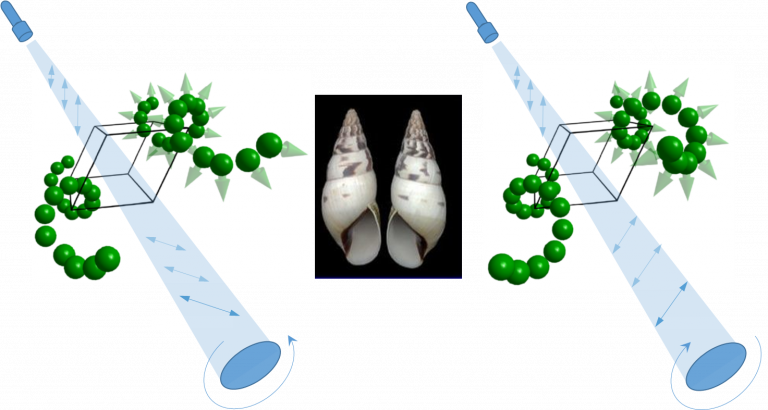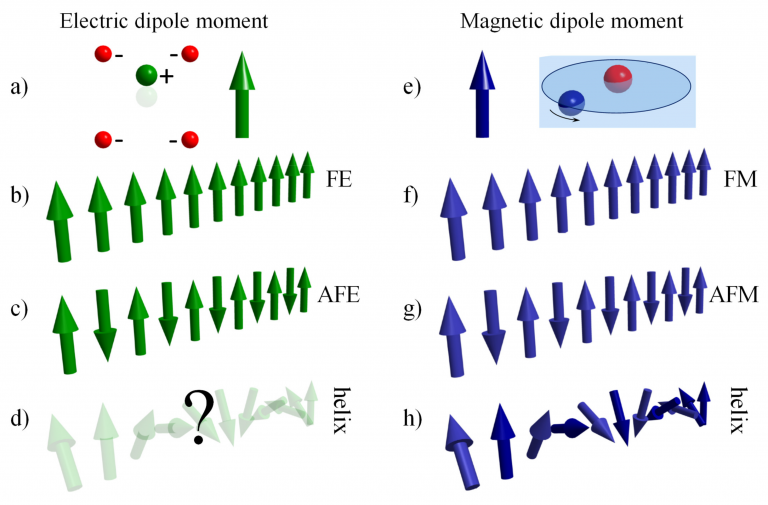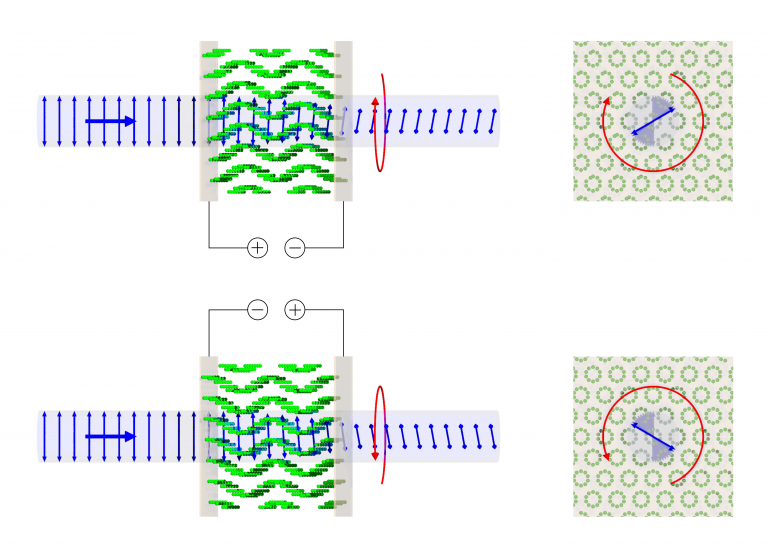UCL Researchers Discover a Helix of Electric Dipoles
7 August 2020
Researchers at UCL in collaboration with ISIS, the UK Neutron and Muon source, University of Oxford and the Japanese National Institute of Materials Science have now discovered the existence of helices constructed of the most unexpected components: atomic scale electric dipoles

The helix is a fascinating pattern known since antiquity. It is of great importance in science, not least because of its role in DNA, where the famous “double helix” of atoms was discovered by X-ray scattering. Research done in part at UCL has now discovered the existence of helices constructed of the most unexpected components: atomic scale electric dipoles.
Dipoles are quite familiar on the human scale. Thus, the separation of positive and negative electric charges, as occurs in a charged battery, can be described by an electric dipole – an arrow that points from negative to positive. Similarly, a bar magnet may be represented by a magnetic dipole – an arrow that represents the separation of the north and south poles, which can be thought of as magnetic charges.
On the much smaller atomic scale, the electrons and nuclei of atoms in crystals can arrange themselves to produce electric dipoles (Figure 1a). These dipoles spontaneously emerge in crystals in order to minimise the energy. A crystal may typically contain a trillion trillion such dipoles and they may interact with one another to order into patterns. This gives new types of matter and technologically important properties such as ferroelectricity, where the dipoles are all aligned, or antiferroelectricity. where they have an alternating arrangement (Figures 1b and 1c). These properties are used in light detectors or computer memory for example. In both cases all the dipole arrows lie parallel to the same line or axis – so called collinear order.

Atomic-scale magnetic dipoles can arise from the circulating currents within the atoms of which crystals are made, typically when atoms carry an odd number of electrons (Figure 1e). They can also spontaneously order, giving rise to the material properties of ferromagnetism and antiferromagnetism. As their names suggest, these properties are analogous to the electric dipole states of ferroelectricty and antiferroelectricity (Figures 1f and 1g). Ferromagnetism is simply the strong type of magnetism widely used in technology, from electric motors to computer memory. However, many types of non-collinear ordering of magnetic dipoles are also known, such as helical or cycloidal orders, where the dipoles twist in screw-like patterns (Figure 1h). This can give rise to exotic phenomena such as multiferroicity and magnetic skyrmions, which to date do not have electric dipole counterparts (Figure 1d).
In the present study, Dr. Roger Johnson of UCL, in partnership Dr. Dmitry Khalyavin of the ISIS Neutron and Muon source, with colleagues from ISIS, Oxford University, and the National Institute for Materials Science in Japan, have described the first example of helical ordering of electric dipoles. This comes nearly sixty years after the independent discoveries of helical magnetism by Japanese and American scientists in the late 1950’s and early 1960’s. The authors discovered the helical order of electric dipoles in a crystalline material containing the elements bismuth, copper, manganese and oxygen, and with chemical formula BiCuxMn7-xO12. Their discovery completes the analogy between ordering of magnetic and electric dipoles in the solid state.
The discovery was made through a combination of advanced experimental techniques. BiCuxMn7-xO12 samples were synthesised in Japan under conditions of very high-pressure and temperature while the helical ordering was established by scattering neutrons and X-rays from the sample at international facilities in Japan and in the UK. The neutrons and X-rays scattered from the atoms in the atomic-scale dipoles, and the helical pattern of dipoles was then deduced from careful analysis of the scattering pattern. The authors also established exactly how the helical ordering arises from the arrangement of atoms in BiCuxMn7-xO12.

A remarkable prediction made by the authors is that the chirality or `handedness’ of the electric dipole helix can be switched by application of an electric field. If this can be demonstrated in a prototype device (e.g. Figure 2), it will have profound implications for technology because many devices in computers or light based electronic components for example rely on switching of microscopic states.
Dr. Roger Johnson says “This is an exciting discovery because it suggests that helices of electric dipoles could behave like their magnetic counterparts, with the implication of exotic states and novel technological applications ”.
The work is published in Science: D. D. Khalyavin et al., Science, Vol. 369, Issue 6504, pp. 680-684 (07 Aug 2020)
Images
- Fig. 1a: a) Electric dipole formed of atoms, b) ferroelectric (FE) and c) antiferroelectric (AFE) alignment of electric dipoles, d) elusive electric dipole helix, e) atomic magnetic dipole, f) ferromagnetic (FM) and g) antiferromagnetic (AFM) alignment of magnetic dipoles, and h) magnetic dipole helix.
- Fig. 2: A hypothetical switchable optically active device in which the sign of rotation (red arrow) of the polarization of linearly polarized light (blue arrows) can be controlled by an electric field. The atomic dipolar helices are represented by green spheres.
Links
- Article in Science
- Dr Roger Johnson's academic profile
- UCL London Centre for Nanotechnology
- ISIS Neutron and Muon Source
 Close
Close

